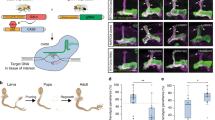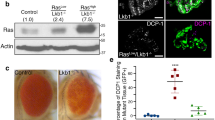Abstract
This protocol describes a method to allograft Drosophila larval tissue into adult fly hosts that can be used to assay the tumorigenic potential of mutant tissues. The tissue of interest is dissected, loaded into a fine glass needle and implanted into a host. Upon implantation, nontransformed tissues do not overgrow beyond their normal size, but malignant tumors grow without limit, are invasive and kill the host. By using this method, Drosophila malignant tumors can be transplanted repeatedly, for years, and therefore they can be aged beyond the short life span of flies. Because several hosts can be implanted using different pieces from a single tumor, the method also allows the tumor mass to be increased to facilitate further studies that may require large amounts of tissue (i.e., genomics, proteomics and so on). This method also provides an operational definition of hyperplastic, benign and malignant growth. The injection procedure itself requires only ∼1 d. Tumor development can then be monitored until the death of the implanted hosts.
This is a preview of subscription content, access via your institution
Access options
Subscribe to this journal
Receive 12 print issues and online access
$259.00 per year
only $21.58 per issue
Buy this article
- Purchase on Springer Link
- Instant access to full article PDF
Prices may be subject to local taxes which are calculated during checkout






Similar content being viewed by others
References
Gonzalez, C. Drosophila melanogaster: a model and a tool to investigate malignancy and identify new therapeutics. Nat. Rev. Cancer 13, 172–183 (2013).
Pandey, U.B. & Nichols, C.D. Human disease models in Drosophila melanogaster and the role of the fly in therapeutic drug discovery. Pharmacol. Rev. 63, 411–436 (2011).
Stark, M.B. A benign tumor that is hereditary in Drosophila. Proc. Natl. Acad. Sci. USA 12, 573–580 (1919).
Bilder, D. Epithelial polarity and proliferation control: links from the Drosophilaneoplastic tumor suppressors. Genes Dev. 18, 1909–1925 (2004).
Brumby, A.M. & Richardson, H.E. Using Drosophila melanogaster to map human cancer pathways. Nat. Rev. Cancer 5, 626–639 (2005).
Caussinus, E. & Gonzalez, C. Induction of tumor growth by altered stem-cell asymmetric division in Drosophila melanogaster. Nat. Genet. 37, 1125–1129 (2005).
Gateff, E. Malignant neoplasms of genetic origin in Drosophila melanogaster. Science 200, 1448–1459 (1978).
Wu, M., Pastor-Pareja, J.C. & Xu, T. Interaction between Ras(V12) and scribbled clones induces tumour growth and invasion. Nature 463, 545–548 (2010).
Beaucher, M., Hersperger, E., Page-McCaw, A. & Shearn, A. Metastatic ability of Drosophila tumors depends on MMP activity. Dev. Biol. 303, 625–634 (2007).
Figueroa-Clarevega, A. & Bilder, D. Malignant Drosophila tumors interrupt insulin signaling to induce cachexia-like wasting. Dev. Cell 33, 47–55 (2015).
Kwon, Y. et al. Systemic organ wasting induced by localized expression of the secreted insulin/IGF antagonist ImpL2. Dev. Cell 33, 36–46 (2015).
Hirabayashi, S., Baranski, T.J. & Cagan, R.L. Transformed Drosophila cells evade diet-mediated insulin resistance through wingless signaling. Cell 154, 664–675 (2013).
Castellanos, E., Dominguez, P. & Gonzalez, C. Centrosome dysfunction in Drosophila neural stem cells causes tumors that are not due to genome instability. Curr. Biol. 18, 1209–1214 (2008).
Janic, A., Mendizabal, L., Llamazares, S., Rossell, D. & Gonzalez, C. Ectopic expression of germline genes drives malignant brain tumor growth in Drosophila. Science 330, 1824–1827 (2010).
Dar, A.C., Das, T.K., Shokat, K.M. & Cagan, R.L. Chemical genetic discovery of targets and anti-targets for cancer polypharmacology. Nature 486, 80–84 (2012).
Vidal, M., Wells, S., Ryan, A. & Cagan, R. ZD6474 suppresses oncogenic RET isoforms in a Drosophila model for type 2 multiple endocrine neoplasia syndromes and papillary thyroid carcinoma. Cancer Res. 65, 3538–3541 (2005).
Read, R.D., Cavenee, W.K., Furnari, F.B. & Thomas, J.B. A Drosophila model for EGFR-Ras and PI3K-dependent human glioma. PLoS Genet. 5, e1000374 (2009).
Witte, H.T., Jeibmann, A., Klambt, C. & Paulus, W. Modeling glioma growth and invasion in Drosophila melanogaster. Neoplasia 11, 882–888 (2009).
Gladstone, M. & Su, T.T. Chemical genetics and drug screening in Drosophila cancer models. J. Genet. Genomics 38, 497–504 (2011).
Willoughby, L.F. et al. An in vivo large-scale chemical screening platform using Drosophila for anti-cancer drug discovery. Dis. Model Mech. 6, 521–529 (2013).
Sullivan, W., Ashburner,, M. & Hawley, R.S. Drosophila Protocols (Cold Spring Harbor Laboratory Press, 2000).
Gonzalez, C. Spindle orientation, asymmetric division and tumour suppression in Drosophila stem cells. Nat. Rev. Genet. 8, 462–472 (2007).
Rossi, F. & Gonzalez, C. Synergism between altered cortical polarity and the PI3K/TOR pathway in the suppression of tumour growth. EMBO Rep. 13, 157–162 (2012).
Chambers, R. A simple micro-injection apparatus made of steel. Science 54, 552–553 (1921).
Ephrussi, B. & Beadle, G.W. A technique for transplantation of Drosophila. Amer. Nat. 70, 218–225 (1936).
Beadle, G.W. & Ephrussi, B. Transplantation in Drosophila. Proc. Natl. Acad. Sci. USA 21, 642–646 (1935).
Bodenstein, D. The postembryonic development of Drosophila. in Biology of Drosophila (Demerec, M., ed.) 275–367 (Wiley, New York, 1950).
Ursprung, H. In vitro culture of Drosophila imaginal discs. in Methods in Developmental Biology (eds. Wilt, F. & Wessels, N.) 485–492 (Thomas Y. Crowell Company, 1967).
Hadorn, E. Transdetermination in cells. Sci. Am. 219, 110–114 (1968).
Schubiger, G. Regeneration, duplication and transdetermination in fragments of the leg disc of Drosophila melanogaster. Dev. Biol. 26, 277–295 (1971).
Schubiger, G. & Hadorn, E. Auto- and allotypic differentiation in vivo cultivated foreleg blastemas of Drosophila melanogaster. Dev. Biol. 17, 584–602 (1968).
Gateff, E. & Schneiderman, H.A. Neoplasms in mutant and cultured wild-type tissues of Drosophila. Natl. Cancer Inst. Monogr. 31, 365–397 (1969).
Woodhouse, E., Hersperger, E. & Shearn, A. Growth, metastasis, and invasiveness of Drosophila tumors caused by mutations in specific tumor suppressor genes. Dev. Genes Evol. 207, 542–550 (1998).
Watson, K.L., Justice, R.W. & Bryant, P.J. Drosophila in cancer research: the first fifty tumor suppressor genes. J. Cell Sci. Suppl. 18, 19–33 (1994).
Herranz, H., Hong, X., Hung, N.T., Voorhoeve, P.M. & Cohen, S.M. Oncogenic cooperation between SOCS family proteins and EGFR identified using a Drosophila epithelial transformation model. Genes Dev. 26, 1602–1611 (2012).
Dekanty, A., Barrio, L., Muzzopappa, M., Auer, H. & Milan, M. Aneuploidy-induced delaminating cells drive tumorigenesis in Drosophila epithelia. Proc. Natl. Acad. Sci. USA 109, 20549–20554 (2012).
Eroglu, E. et al. SWI/SNF complex prevents lineage reversion and induces temporal patterning in neural stem cells. Cell 156, 1259–1273 (2014).
Sievers, C., Comoglio, F., Seimiya, M., Merdes, G. & Paro, R. A deterministic analysis of genome integrity during neoplastic growth in Drosophila. PLoS ONE 9, e87090 (2014).
Lin, H. & Spradling, A.C. Germline stem cell division and egg chamber development in transplanted Drosophila germaria. Dev. Biol. 159, 140–152 (1993).
Srdic, Z. & Jacobs-Lorena, M. Drosophila egg chambers develop to mature eggs when cultured in vivo. Science 202, 641–643 (1978).
Roberts, P.A., Iredale, R.B. & Buckley, P.M. The consequences of fat body transplantation into young and old Drosophila. Exp. Gerontol. 20, 123–130 (1985).
Shearn, A. & Garen, A. Genetic control of imaginal disc development in Drosophila. Proc. Natl. Acad. Sci. USA 71, 1393–1397 (1974).
Markstein, M. et al. Systematic screen of chemotherapeutics in Drosophila stem cell tumors. Proc. Natl. Acad. Sci. USA 111, 4530–4535 (2014).
Katsuyama, T. & Paro, R. Innate immune cells are dispensable for regenerative growth of imaginal discs. Mech. Dev. 130, 112–121 (2013).
Morais da Silva, S., Moutinho-Santos, T. & Sunkel, C.E. A tumor suppressor role of the Bub3 spindle checkpoint protein after apoptosis inhibition. J. Cell Biol. 201, 385–393 (2013).
Rebollo, E., Llamazares, S., Reina, J. & Gonzalez, C. Contribution of noncentrosomal microtubules to spindle assembly in Drosophila spermatocytes. PLoS Biol. 2, E8 (2004).
Lee, T. & Luo, L. Mosaic analysis with a repressible cell marker for studies of gene function in neuronal morphogenesis. Neuron 22, 451–461 (1999).
Golubovsky, M.D., Weisman, N.Y., Arbeev, K.G., Ukraintseva, S.V. & Yashin, A.I. Decrease in the lgl tumor suppressor dose in Drosophila increases survival and longevity in stress conditions. Exp. Gerontol. 41, 819–827 (2006).
Roegiers, F. et al. Frequent unanticipated alleles of lethal giant larvae in Drosophila second chromosome stocks. Genetics 182, 407–410 (2009).
Acknowledgements
J. Szabad kindly hosted and demonstrated this technique to C.G. at the Department of Medical Biology, University of Szeged, in 2003. His contribution is greatly appreciated. Work in our laboratory is supported by grants AdG 2011 294603 advanced grant from the European Research Council, BFU2012–32522 from the Spanish Ministerio de Economí y Competitividad (MINECO) and Agaur 2014 SGR 100 from Generalitat de Catalunya.
Author information
Authors and Affiliations
Contributions
C.G. and F.R. designed the experiments. C.G. implemented the protocol. F.R. conducted the experiments and prepared all the supporting media. C.G. and F.R. wrote the paper.
Corresponding author
Ethics declarations
Competing interests
The authors declare no competing financial interests.
Supplementary information
Supplementary Text and Figures
Supplementary Methods (PDF 84 kb)
Rights and permissions
About this article
Cite this article
Rossi, F., Gonzalez, C. Studying tumor growth in Drosophila using the tissue allograft method. Nat Protoc 10, 1525–1534 (2015). https://doi.org/10.1038/nprot.2015.096
Published:
Issue Date:
DOI: https://doi.org/10.1038/nprot.2015.096
This article is cited by
-
Drosophila innate immunity suppresses the survival of xenografted mammalian tumor cells
Scientific Reports (2023)
-
The level of oncogenic Ras determines the malignant transformation of Lkb1 mutant tissue in vivo
Communications Biology (2021)
-
Collective cell migration and metastases induced by an epithelial-to-mesenchymal transition in Drosophila intestinal tumors
Nature Communications (2019)
-
Microenvironmental autophagy promotes tumour growth
Nature (2017)
-
Phosphoenolpyruvate Carboxykinase Maintains Glycolysis-driven Growth in Drosophila Tumors
Scientific Reports (2017)
Comments
By submitting a comment you agree to abide by our Terms and Community Guidelines. If you find something abusive or that does not comply with our terms or guidelines please flag it as inappropriate.



